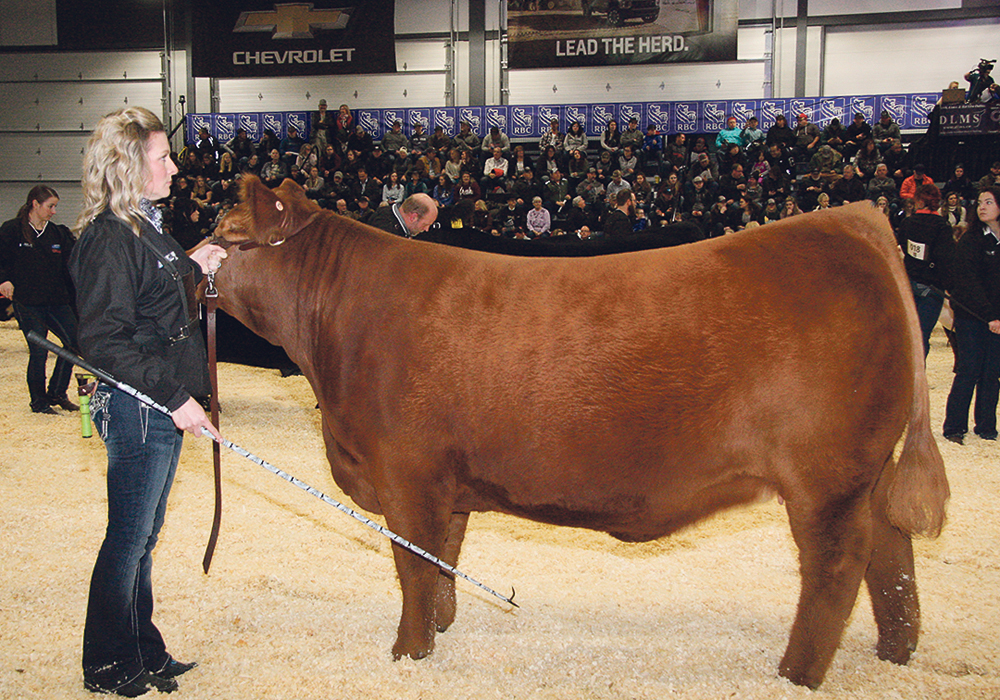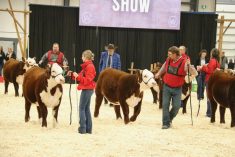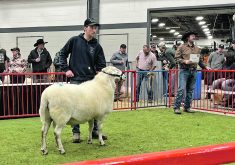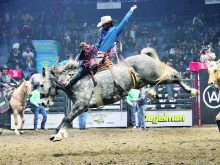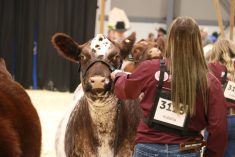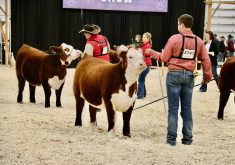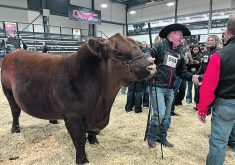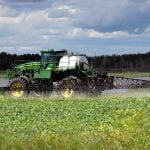The cattle have changed in style and colour since a French bull named Prince Pompadour arrived in Quebec in 1968
REGINA — When a Limousin bull got the big prize at the Canadian Western Agribition supreme championship final, a roaring cheer came from the stands.
Named Greenwood Electric Impact ET, this bull was the son of the 2017 champion establishing Limousin as an important part of the Canadian beef industry.
The breed is celebrating 50 years in Canada and is one of the top five associations in this country.
Sale manager Martin Bohrson joined the business in 1974 and is a long-time believer in the breed.
“The main reason is I really liked their moderate frame. The cattle were easy doing, excellent muscling, very acceptable for feeding and carcass results,” he said.
Read Also

Mixed results on new African swine fever vaccine
The new African swine fever vaccine still has issues, but also gave researchers insight into how virus strain impacts protection against the deadly pig disease.
The cattle have changed in style and colour since a French bull named Prince Pompadour landed in Quebec in 1968.
Some improvements were needed for Canadian conditions like better hair coats and docility but this European breed did not have calving problems and the carcasses were lean and high yielding. They dominated the Agribition carcass competition for years.
“They are still among the best for carcass yield and feed efficiency,” he said.
Now working with Bohrson Marketing, he hears customers asking if the cattle are polled and if they offer calving ease.
“They want convenience with calving ease but they want good growth patterns in the calf crop because pounds are dollars,” he said.
His grandchildren now own and show Limousin cattle.
“I liked the style and eye appeal of the cattle. We were showing in 4-H and these calves were interesting,” he said.
The Payne family of Lloydminster joined the parade in 1974. The family had a commercial herd and Bernie Payne tried various continental breeds with artificial insemination and liked the Limousin calves best, said daughter-in-law Jackie Payne.
“They saw the benefits of a fast turnaround in getting calves to market,” she said.
Scott and Jackie along with their sons raise Limousin, Angus and recently added Speckle Park.
They have shone in the show ring but their best customers are commercial producers looking for good gains and well-muscled cattle.
“Our big bull market is the commercial guy and 90 percent of our buyers are repeat customers, buyers who have been with us for 20 years,” she said.
In the early days, the cattle were taller and needed improvements.
“They have really changed so they were stouter made cattle with volume and softness and muscle. It has been a 360-degree turn in 20 years,” she said.
Commercial buyers keep coming back.
“We sell a lot of our bulls sight unseen to our customers because they do trust us and we know what they need,” she said.
Ashton and Kendra Hewson are new breeders and obtained semen from Payne’s champion bull named Greenwood Canadian Impact ET.
When Ashton retired from his hockey career with the Prince Albert Raiders, he and Kendra set up Double B Cattle at Unity, Sask. His family was involved with the breed from the beginning and he wanted to continue.
With help from his uncle, Bob Hewson, they started with four cows five years ago. This spring they are calving out 25 and the plan is to keep expanding even though both work off-farm.
“We set goals for our operation. I think that is very important in a purebred operation because if you don’t have plans, what are you looking for?” he asked during an interview at Agribition, after they won the grand champion female award with a daughter of Canadian Impact.
“As soon as she hit the ground, we knew she was going to be a good one,” said Kendra, who works for Cargill.
“We wanted to be competitive. We wanted to bring some calves and females here that would be competitive and put a name out for ourselves,” Ashton said.
The Hewsons are starting to sell some bulls privately and are making contacts and friends because of their association with Limousin.
“I am very passionate about this breed,” said Ashton.
“We are very passionate about what we do with our cattle. We don’t worry about ourselves, we care about what everybody is doing and what is going on. With a breed of our size we have to work and stick together to improve the breed and improve the cattle. We have made huge strides in the last 10 years,” he said.
Winning grand champion was an accolade.
“It just warms my heart to be out there and to be with such magnificent breeders and other cattle. It is just so humbling to walk out there with an animal like that and do so well,” Kendra said.
The winning cow will form the basis of their future. The grand dam and dam set a good foundation for them to build their purebred herd.
“She still has to be a functional cow when she goes back home. She goes in with the other cows and she has to earn her keep,” Ashton said.
Cattle that pay their own way are an important consideration for Wulf Cattle, the largest Limousin producer in North America.
The company has about 2,000 cows and sells 650 purebred bulls, as well as Lim-Flex, a cross between Angus and Limousin, said Casey Fanta.
They feed about 100,000 a year in three states and a high percentage come from their Limousin bull customers.
The Wulf family were early adopters of the breed in the United States.
“They were cattle feeders before they were cattle breeders,” Fanta said.
“The Limousin cattle that have come here over 50 years ago have been adapted to both our marketplace and our environment that we have to raise them.”
The plan is to create cattle that produce high yielding, top grade cattle.
“The main thing that has changed for us, in the U.S., the cattle have to grade. We have to have Choice cattle. We used to raise some Select grade cattle and those went into specialty programs,” he said.
The Choice-Select price spread has become so wide if the cattle grade leaner it is a financial loss.
Customers are looking for good muscling in bulls and the company often buys the resulting commercial calves that fit into different programs for natural beef, as well as specialized hormone-free and antibiotic-free programs.
The company offers traceback using electronic identification and returns carcass data to all producers. They will meet with producers to guide improvements in marbling and muscling.
- Limousin cattle came from the Aquitaine region of France. The first herd book was set up in France in 1886.
- They were first imported to Canada in 1968.
- The breed is one of the top five in Canada.
- The first Limousin imported to Canada was Prince Pompadour, which arrived in November 1968.
- The first Limousin bulls imported permanently into the United States arrived in the fall of 1971.
- The Canadian government did not permit any Limousin bulls to leave the country except for short periods for exhibition purposes, and then only if owners posted a large bond that was refunded when the animal returned to Canada.
- The first American Limousin import, Kansas Colonel, was born and raised in Canada and was imported by Bob Haag of Topeka, Kansas, for a group of Kansas Limousin breeders. Limousin semen was used earlier on Angus cows in the Denver area.
Source: Canadian Limousin Association


